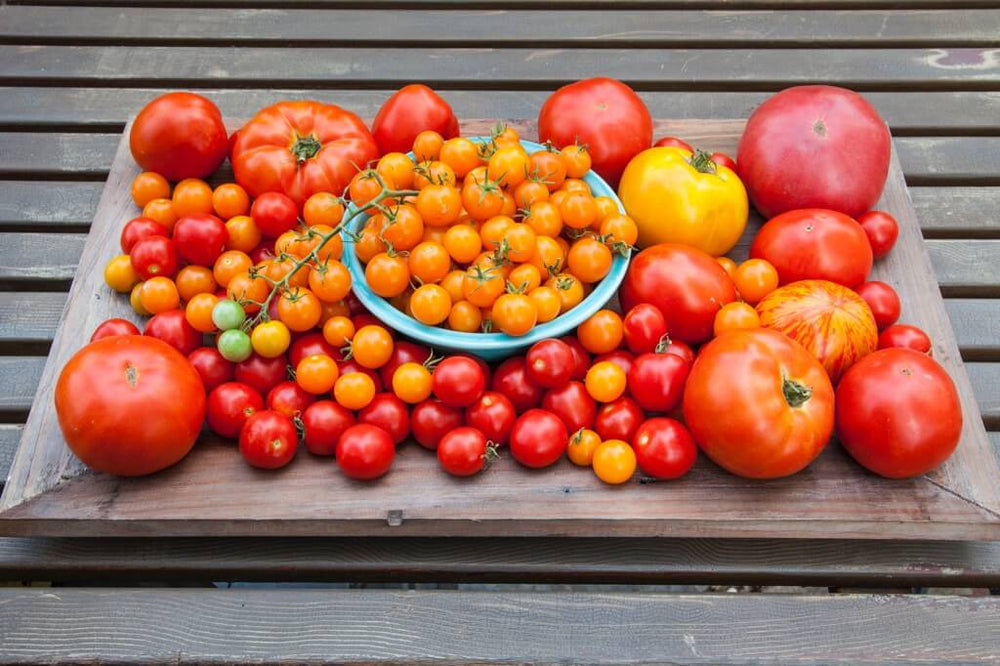TomAYto, tomAHto...just as there are different pronunciations, there is also a wide variety of tomato types, with a range of colors, sizes, flavors, uses—the list goes on. So how do you know which variety will be best for your garden and your plate? Here are some things to consider.
Tomato Plant Sizes
Do you have a large garden or a small patio? Your answer to that question can help you decide which type of tomato to grow. Tomato varieties are labeled as either indeterminate or determinate, but don't let those terms scare you:
Indeterminate tomato plants grow continuously until killed by frost or disease, producing fruit through the entire growing season. Most (though not all) indeterminate varieties grow quite tall—some reaching as much as 8 or 10 feet—so they need a lot of room and support. Chocolate Sprinkles, Mr. Stripey, and Bonnie Original are all examples of indeterminate tomato plants.
Determinate tomato plants tend to be shorter—they reach a certain height and then stop growing. This makes them a wonderful choice for smaller spaces like side yards, balconies, and decks. Determinate tomato plants also produce the majority of their fruit within a shorter period of time, which is perfect if you plan to preserve the harvest. Some examples include Better Bush, Celebrity, and Roma.
You may also see the term "dwarf" or "compact" on the plant tag. These plants, such as Sweet ‘n Neat, rarely top more than 2 or 3 feet, and can be determinate or indeterminate. They grow beautifully in containers, and some, like the cascading Tumbling Tom, are just right for hanging baskets.
Hybrid vs. Heirloom
Once you figure out the size of tomato plant that's appropriate for your garden, it's time to think about whether you'd like to grow hybrid or heirloom plants—or a mix of both.
Hybrid tomato plants are, simply, plants that have been crossbred to take advantage of the best traits of each parent plant. These traits might include greater disease resistance, shorter growth habit, or higher yield. Plant breeders may do the cross-pollination to create a certain kind of hybrid, or a hybrid can occur naturally, thanks to bees and other pollinators. It's important to note that hybrid is NOT the same as GMO. Some of Bonnie's most popular hybrids include Sun Gold, Better Boy, and Juliet.
Heirloom tomato plants are varieties that are open-pollinated (meaning they rely on insect pollination) and at least 50 years old. Many, like Cherokee Purple, Arkansas Traveler, and Pink Brandywine, offer a rich history passed down through cultures or families.
Tomato Uses
When choosing tomato varieties, it's also important to consider how you plan to use the fruit. Do you prefer eating tomatoes in salads? Are you planning to cook vats of your grandma's secret tomato sauce recipe? Or maybe you like to use tomatoes in lots of ways—snacking on them fresh, grilling them on kebabs, slicing them to star in the perfect tomato sandwich.
Salad/snacking tomatoes are bite-sized cherry or grape tomatoes like Sweet Million, Sun Sugar, and Tami G Grape. These make perfect additions to salads, kebabs, or frittatas. Or just eat them straight from the vine!
Slicing tomatoes are medium to extra large, round, juicy tomatoes, where a slice fits perfectly on a sandwich. These include humongous beefsteak tomatoes like Red Beefsteak or German Johnson, as well as more moderately-sized ones like Rutgers and Early Girl.
Sauce/paste tomatoes are meaty and dense, making them ideal for sauces and pastes. Popular varieties include Roma, San Marzano, and Heinz Super Roma.




Tomato Colors and Flavors
Tomato varieties come in a glorious rainbow of colors. Generally, the color will give you a hint about the tomato's flavor, though your growing conditions can have a big effect as well.
Pink tomatoes, like Arkansas Traveler and Pink Girl, have "classic" or "old-fashioned" tomato taste with a nice flavor balance of acid and sugar.
Red tomatoes, like Bonnie Centennial and Super Fantastic, boast robust, slightly more acidic flavors that many people find reminiscent of their grandparents' tomatoes.
Black or purple tomatoes, like Black Cherry and Cherokee Purple, have flavors that are often described as "earthy," "complex," or even "smoky."
Orange or yellow tomatoes, like Golden Jubilee and Lemon Boy, tend to have bright, mild flavors.
Size can also have an effect on flavor. Cherry tomatoes, for example, taste sweeter than larger tomatoes thanks to higher concentrations of sugar. For more on this topic, check out our The Basics of Tomato Flavor article.
So go ahead and mix and match! No matter what tomato varieties you select—heirloom, indeterminate, hybrid, purple, dwarf, cherry, orange, beefsteak—you'll enjoy a delicious summer filled with tasty tomatoes from Bonnie Plants®. (Still have questions about which tomato variety is right for you? Check out our handy Tomato Chooser.)





 Herbs
Herbs
 Vegetables
Vegetables
 Fruit
Fruit
 Flowers
Flowers
 Succulents
Succulents
